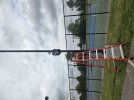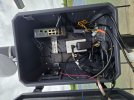- Jul 12, 2015
- 79
- 40
Finally after several months of having this project on my mind, we finally pulled the trigger and got it done. Thanks to a wonderful maintenance crew who were able to help get the power sorted and getting it wired up into the box, made my camera install a lot less complicated.
Here's the end result. The inside setup is a little janky, but for being my first time doing this kind of project, I'm just thrilled it's done and working like a champ. We ordered the box and supplies from Amazon. I thought the 'blue light' on the box was a nice added touch to hopefully get people's attention that there are security cameras watching. This parking area runs right along two city streets that T into each other, but is still kind of secluded from everything, especially at night. The area still tends to see activity at night, from people walking/exercising late at night, or um, other extracurricular activities. Maybe the folks that notice will perhaps have some tiny sense of security and peace of mind, while also hopefully serving as a deterrent.
Wanted to post these pictures here, just in case it helps somebody else out there who maybe has this idea and wants to DIY it. Feel free to critique.
Edit:
Also wanted to add: the pictures don't show where I went back and caulked around the camera base and other holes that were drilled. Just FYI.
Here's the end result. The inside setup is a little janky, but for being my first time doing this kind of project, I'm just thrilled it's done and working like a champ. We ordered the box and supplies from Amazon. I thought the 'blue light' on the box was a nice added touch to hopefully get people's attention that there are security cameras watching. This parking area runs right along two city streets that T into each other, but is still kind of secluded from everything, especially at night. The area still tends to see activity at night, from people walking/exercising late at night, or um, other extracurricular activities. Maybe the folks that notice will perhaps have some tiny sense of security and peace of mind, while also hopefully serving as a deterrent.
Wanted to post these pictures here, just in case it helps somebody else out there who maybe has this idea and wants to DIY it. Feel free to critique.
Edit:
Also wanted to add: the pictures don't show where I went back and caulked around the camera base and other holes that were drilled. Just FYI.




 Still cheaper tham trenching the lot to install 120v power to each pole we used.
Still cheaper tham trenching the lot to install 120v power to each pole we used.